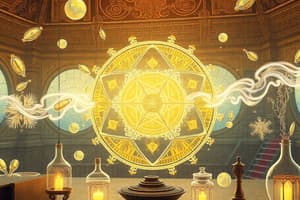Podcast
Questions and Answers
Who proposed the plum pudding model of the atom?
Who proposed the plum pudding model of the atom?
- Erwin Schrödinger
- Niels Bohr
- John Dalton
- J.J. Thomson (correct)
Which atomic model postulated that electrons orbit the nucleus in distinct energy levels?
Which atomic model postulated that electrons orbit the nucleus in distinct energy levels?
- Dalton's Model
- Quantum Mechanical Model
- Bohr's Model (correct)
- Plum Pudding Model
What subatomic particle was discovered as atomic theory evolved?
What subatomic particle was discovered as atomic theory evolved?
- Proton
- Neutron (correct)
- Molecule
- Electron
Which scientist laid out the atomic theory in the early 19th century?
Which scientist laid out the atomic theory in the early 19th century?
What tool was developed to organize elements based on their properties?
What tool was developed to organize elements based on their properties?
What is the primary responsibility of a neutron in an atom?
What is the primary responsibility of a neutron in an atom?
Which particle is primarily responsible for the positive charge of an atom?
Which particle is primarily responsible for the positive charge of an atom?
How does the electron configuration of an atom affect its chemical behavior?
How does the electron configuration of an atom affect its chemical behavior?
What did Schrödinger's quantum mechanical model describe about electrons in atoms?
What did Schrödinger's quantum mechanical model describe about electrons in atoms?
How is Dmitri Mendeleev's periodic table organized?
How is Dmitri Mendeleev's periodic table organized?
Flashcards are hidden until you start studying
Study Notes
Structure of Atoms: Unraveling the Building Blocks of Chemistry
Chemistry's quest to understand matter began with the development of atomic theory, which postulates that all substances are made up of tiny, indivisible particles called atoms. As this concept evolved, we've refined our models of atoms, discovered subatomic particles, and developed the periodic table as a tool to organize the elements.
Atomic Theory
Atomic theory, centered on the work of John Dalton, posited that elements were composed of indivisible particles called atoms and that compounds consisted of atoms of different elements combined in a fixed ratio. Dalton's theory, laid out in the early 19th century, was a groundbreaking achievement that paved the way for modern atomic concepts.
Atomic Models
The field of atomic models has seen numerous developments, from J.J. Thomson's plum-pudding model to Niels Bohr's solar system model and Erwin Schrödinger's quantum mechanical model. These models helped us visualize the structure of atoms and led to a deeper understanding of the behavior of electrons.
- Plum Pudding Model: Thomson proposed that the atom was like a positively charged sphere with an evenly distributed, negatively charged substance resembling fruit in plum pudding.
- Bohr's Model: Bohr postulated that electrons orbit the nucleus in distinct energy levels, and the atom can absorb or emit energy only when an electron transitions between levels.
- Quantum Mechanical Model: Schrödinger's model described the probability of finding an electron within an atom using mathematical equations and wave functions, a more accurate representation of atomic structure.
Subatomic Particles
Beyond atoms, we've discovered subatomic particles:
- Proton: A positively charged particle found in the nucleus of an atom, primarily responsible for its positive charge.
- Neutron: A neutral particle found in the nucleus of an atom, contributing to its mass and helping to keep the nucleus together.
- Electron: A negatively charged particle that orbits around the nucleus and is responsible for the chemical behavior of the atom.
Electron Configuration
Electron configuration is a way to describe the arrangement of electrons in an atom's energy levels. This information is vital for predicting an atom's chemical behavior, reactivity, and color.
The periodic table, first proposed by Dmitri Mendeleev, is organized by the atomic number, or the number of protons in the nucleus of an atom, and is used to display the electron configuration of elements.
The periodic table has undergone many revisions since its introduction, with the addition of new elements and the occasional rearrangement of some elements to better reflect their properties.
Understanding these fundamental building blocks of chemistry and their relationships allows us to uncover the intricate workings of matter and the world around us. As we delve deeper into the world of atoms, the mysteries of the universe continue to unfold in fascinating ways.
Studying That Suits You
Use AI to generate personalized quizzes and flashcards to suit your learning preferences.




